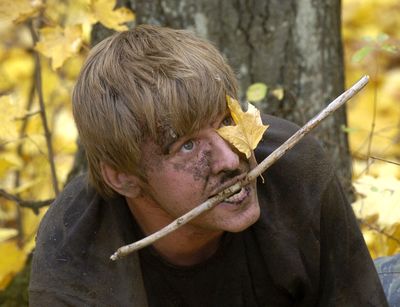UI actors tap inner animals
Class offers students a unique perspective

MOSCOW, Idaho – Over the years, police have responded to the University of Idaho Arboretum to investigate complaints of disturbing sounds, sounds like moaning, screaming and growling.
One day this fall, the sounds began again with a bark, then a howl, then snarls. In the shadows of the trees, a man and woman on all fours circled each other warily. The man, with the swinging gait of a gorilla, swept leaves from before him and grunted. With the throaty feline growl of a panther, the woman screamed, “Ow, owwww owwww, owwww!”
The sound is human, yet inhuman, leading to how this came to be the only UI class to repeatedly evoke a police response. Among UI theater students, the animals acting class is legendary.
Senior James Napoleon Stone loped through the trees, cackling like a hyena. He lifted his head to sniff the air, then dropped and rolled in the dirt. Stone stepped out of character to describe what goes through his mind as a hyena in the arboretum.
“I check in and ask, ‘Am I safe? What’s my proximity to danger? What decisions do I make to come out on top?’ It’s hard to talk about without sounding crazy,” said Stone, barefoot, out of breath and coated in sweat and dirt.
There’s no Shakespeare or sonnets for animals, he said. This is the chance as an actor to experience the most basic modes of survival.
Professor David Lee-Painter crouched in the bushes, whispering encouragement and advice to his students. He patterned the animals class after one he took from Jean Scharfenberg at Illinois State University. Other actors who took that class include John Malkovich, Laurie Metcalf, Moira Harris and Tom Irwin. His class differs because it is actually outside.
“They can really smell the earth and dig in the earth with their bare hands and feet,” Lee-Painter said.
For the class, students choose and research an animal. Predators are recommended. They spend a day observing it at Seattle’s Woodland Park Zoo before transforming for three hours a week to hunt, fight and kill.
“Early on, it’s really hard. Their muscles hurt, because we don’t move that fast,” Lee-Painter said. “They learn a lot about their ability to be more physically engaged.”
Senior Peter Beard, a mountain gorilla, had wanted to take the class since his freshman year.
“It’s incredible work. It’s breakthrough work, coupled with stretching your imagination and getting back to that place of childhood imagination,” he said. “You find out a lot about yourself: what you are afraid of and how you deal as a person with what gets thrown at you.”
Students must quickly get over any embarrassment at howling while peers jog by. They forget about tugging down clothing, which inevitably rides up during a violent skirmish at the communal watering hole, a plastic storage bin with fresh water.
“After a few weeks running around the arboretum as a baboon you kind of lose your inhibitions,” said John J. O’Hagan, who took the UI animals class in 2005 and is now an assistant professor of theater at the University of Wyoming. It’s also extremely physical, he said. As a vicious, blue-faced Chacma baboon, he separated his knuckles while walking on them.
“Every day you knew it was possible that you were going to have some kind of altercation, some conflict, and that it was probably going to be very, VERY physical, and you had the option to run from it or face it,” he said by e-mail. “As an actor, to explore every moment as if it might be your last leads you to make very strong, dynamic choices, and you realize that’s what makes the work theatrical.”
The class has offered theatrics for unwitting passers-by.
Lee-Painter doesn’t know why someone would ask directions from a man on all fours with a stuffed animal dangling from his mouth, but it happened. The student/wolf growled and slunk back into the bushes, he said. They’re told to stay in character no matter what, but civilian attacks are not allowed.
One jogger called the police and insisted they go into the arboretum to see for themselves what was happening. The officer walked into the forest and demanded to be shown. After a few seconds of observing growling and panting, he threw up his hands and said, “OK, I’ve seen enough,” and left.
Another time, Lee-Painter was running through the arboretum with a pack of “assassin animals,” class alumni who come back to “kill” current students.
“I’ve got this pack of animals behind me, and we run into this huge crowd on a tour. There was a guy in a suit with his mouth open. What must they think? ‘Welcome to the University of Idaho.’ ”
The high point of the class is “the kill,” a fight to the death with an imaginary attacker.
It’s an emotional experience for many students.
Beard described the kill as taking down your biggest fear. “It’s intense, watching everyone go through that process,” he said.